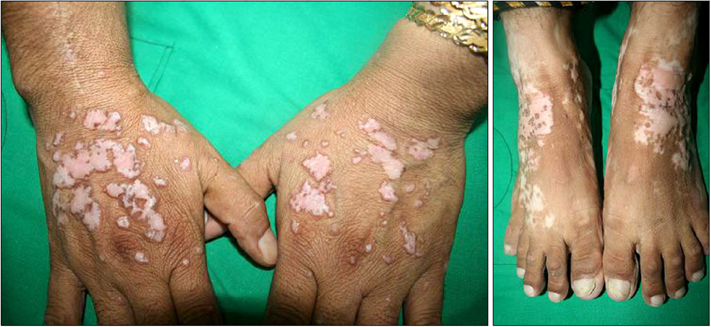Ann Dermatol.
2013 May;25(2):223-225. 10.5021/ad.2013.25.2.223.
Familial Colocalization of Lichen Planus and Vitiligo on Sun Exposed Areas
- Affiliations
-
- 1Department of Dermatology, Hormozgan University of Medical Sciences, Bandar Abbas, Iran. swt_f@yahoo.com
- 2Department of Pathology, Hormozgan University of Medical Sciences, Bandar Abbas, Iran.
- 3Infectious Disease Research Center, Hormozgan University of Medical Sciences, Bandar Abbas, Iran.
- KMID: 2171793
- DOI: http://doi.org/10.5021/ad.2013.25.2.223
Abstract
- Lichen planus and vitiligo are common skin disorders. Colocalization which is rarely reported may consider the koebner phenomenon related to the photo damage causing initiation of lichen planus over vitiliginous skin. We report a 37-year-old mother and her 23-year-old daughter, both farmers and known cases of vitiligo with subsequent gradual onset of pruritic skin lesions of lichen planus starting first over previous vitiliginous skin on sun exposed areas. Coexistence and colocalization of lichen planus and vitiligo in two members of a family is very rare and has not been reported previously according to our knowledge. Predominant colocalization was on vitiliginous areas which may explain actinic damage as a triggering factor for inducing lichen planus in long-standing vitiligo and supports its pathogenic relationship.
Keyword
Figure
Reference
-
1. Veller Fornasa C, Rosin S, Lazzaro M, Tarantello M. Colocalization of vitiligo and lichen planus in a patient with autoimmuue thyroditis. Acta Dermatovenerol Alp Panonica Adriat. 2002. 11:113–114.2. Golchai J, Ramezanpour A. Report of a new case with four skin diseases. Dermatol Online J. 2003. 9:15.
Article3. Anstey A, Marks R. Colocalization of lichen planus and vitiligo. Br J Dermatol. 1993. 128:103–104.
Article4. Ujiie H, Sawamura D, Shimizu H. Development of lichen planus and psoriasis on lesions of vitiligo vulgaris. Clin Exp Dermatol. 2006. 31:375–377.
Article5. Hafez M, Sharaf L, Seafan FA. The inheritance of susceptibility to lichen planus. Indian J Dermatol. 2006. 51:73.
Article6. Alkhateeb A, Fain PR, Thody A, Bennett DC, Spritz RA. Epidemiology of vitiligo and associated autoimmune diseases in Caucasian probands and their families. Pigment Cell Res. 2003. 16:208–214.
Article7. Le Poole IC, Sarangarajan R, Zhao Y, Stennett LS, Brown TL, Sheth P, et al. 'VIT1', a novel gene associated with vitiligo. Pigment Cell Res. 2001. 14:475–484.
Article8. Porter SR, Scully C, Eveson JW. Coexistence of lichen planus and vitiligo is coincidental. Clin Exp Dermatol. 1994. 19:366.
Article




